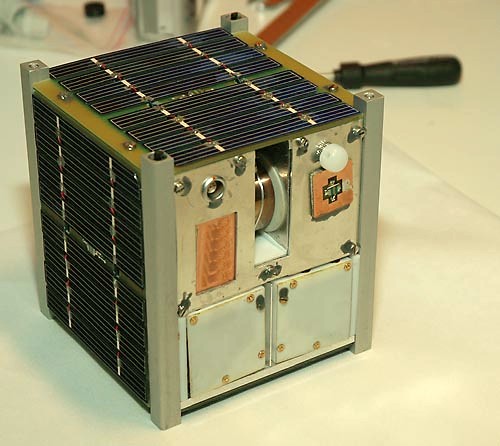|
Damping And Vibrations Experiment
The Damping and Vibrations Experiment (DAVE), also known as CP-7, is a technology demonstration nanosatellite developed by the PolySat laboratory at California Polytechnic State University, San Luis Obispo, in collaboration with Northrop Grumman. The spacecraft adheres to the 1U CubeSat standard and is currently in a 93° inclination orbit. DAVE will study the vibration of metal beams damped with tungsten particles in a micro-gravity environment. The test elements are driven by a piezoelectric actuator, and vibration data is collected via an accelerometer at the tip of each beam. DAVE was launched into a high-inclination orbit as a secondary payload on the final flight of the Delta II launch vehicle as part of the ELaNa-18 ride-share mission with NASA's ICESat-2 primary payload. The launch occurred out of Vandenberg Air Force Base, California on September 15 at 6:02 AM local time. DAVE was deployed alongside three other CubeSat spacecraft: University of Central Florida's SurfSa ... [...More Info...] [...Related Items...] OR: [Wikipedia] [Google] [Baidu] |
Nanosatellite
A small satellite, miniaturized satellite, or smallsat is a satellite of low mass and size, usually under . While all such satellites can be referred to as "small", different classifications are used to categorize them based on mass. Satellites can be built small to reduce the large economic cost of launch vehicles and the costs associated with construction. Miniature satellites, especially in large numbers, may be more useful than fewer, larger ones for some purposes – for example, Satellite#Applications, gathering of scientific data and radio relay. Technical challenges in the construction of small satellites may include the lack of sufficient power storage or of room for a spacecraft propulsion, propulsion system. Rationales One rationale for miniaturizing satellites is to reduce the cost; heavier satellites require larger rockets with greater thrust that also have greater cost to finance. In contrast, smaller and lighter satellites require smaller and cheaper launch ve ... [...More Info...] [...Related Items...] OR: [Wikipedia] [Google] [Baidu] |
ELFIN
Elfin may refer to: *ELFIN, a CubeSat developed by University of California, Los Angeles *Elfin (steamboat), a steamboat that ran on Lake Washington from 1891 to 1900 *Elfin of Alt Clut, ruler of Alt Clut, seventh century Scotland *Elfin, a character from the video game ''The Peace Keepers#Echo.2FElfin, The Peace Keepers'' *Elfin forests, dwarfed plant ecosystems *Elfin rabbit, a domestic rabbit breed *Elfin Sports Cars, an Australian sports car manufacturer *Elfin Team, a hacking group *, one of several British Royal Navy ships *, one of several United States Navy ships *Elfins, North American members of the butterfly genus ''Callophrys'' See also * *Elf *Elphin (other) *Elven (other) *Williams syndrome, a syndrome characterized by an elfin facial appearance {{disambig ... [...More Info...] [...Related Items...] OR: [Wikipedia] [Google] [Baidu] |
CubeSats
A CubeSat is a class of small satellite with a form factor of cubes. CubeSats have a mass of no more than per unit,, url=https://static1.squarespace.com/static/5418c831e4b0fa4ecac1bacd/t/5f24997b6deea10cc52bb016/1596234122437/CDS+REV14+2020-07-31+DRAFT.pdf , title=Cubesat Design Specification , publisher=California Polytechnic State University, San Luis Obispo, Cal Poly SLO , year=2020 , location=San Luis Obispo , pages=12 and often use commercial off-the-shelf (COTS) components for their electronics and structure. CubeSats are deployed into orbit from the International Space Station, or launched as secondary payloads on a launch vehicle. , more than 2,300 CubeSats have been launched. In 1999, California Polytechnic State University (Cal Poly) professor Jordi Puig-Suari and Bob Twiggs, a professor at Stanford University Space Systems Development Laboratory, developed the CubeSat specifications to promote and develop the skills necessary for the design, manufacture, and testing of ... [...More Info...] [...Related Items...] OR: [Wikipedia] [Google] [Baidu] |
Magnetometer
A magnetometer is a device that measures magnetic field or magnetic dipole moment. Different types of magnetometers measure the direction, strength, or relative change of a magnetic field at a particular location. A compass is one such device, one that measures the direction of an ambient magnetic field, in this case, the Earth's magnetic field. Other magnetometers measure the magnetic dipole moment of a magnetic material such as a ferromagnet, for example by recording the effect of this magnetic dipole on the induced current in a coil. The invention of the magnetometer is usually credited to Carl Friedrich Gauss in 1832. Earlier, more primitive instruments were developed by Christopher Hansteen in 1819, and by William Scoresby by 1823. Magnetometers are widely used for measuring the Earth's magnetic field, in geophysical surveys, to detect magnetic anomalies of various types, and to determine the dipole moment of magnetic materials. In an aircraft's attitude and heading ... [...More Info...] [...Related Items...] OR: [Wikipedia] [Google] [Baidu] |
Ham Radio
Amateur radio, also known as ham radio, is the use of the radio frequency spectrum for purposes of non-commercial exchange of messages, wireless experimentation, self-training, private recreation, radiosport, contesting, and emergency communications. The term ''"radio amateur"'' is used to specify ''"a duly authorized person interested in radioelectric practice with a purely personal aim and without pecuniary interest"'' (either direct monetary or other similar reward); and to differentiate it from commercial broadcasting, public safety (police and fire), or two-way radio professional services (maritime, aviation, taxis, etc.). The amateur radio service (''amateur service'' and '' amateur-satellite service'') is established by the International Telecommunication Union (ITU) through their recommended radio regulations. National governments regulate technical and operational characteristics of transmissions and issue individual station licenses with a unique identifying cal ... [...More Info...] [...Related Items...] OR: [Wikipedia] [Google] [Baidu] |
70-centimeter Band
The 70-centimeter or 440 MHz band is a portion of the UHF radio spectrum internationally allocated to amateur radio and amateur satellite use. The ITU amateur radio allocation is from 430 to 440 MHz; however, some countries, such as the United States, allocate hams 420 to 450 MHz. Depending on the country the band is shared with other radio services (in United States with government radar systems such as PAVE PAWS). 70 centimeters is a popular ham band due to the ready availability of equipment in both new and used markets. Most amateurs operating on 70 cm use either equipment purpose-built for ham radio, or commercial equipment designed for nearby land mobile frequencies. Amateurs usually use the band for FM or digital voice communications through repeaters (useful for emergency communications), as well narrow band modes (analog and digital) for long-distance communications (called "DX", including Moon bounce). The band is also popular for Amateur Satel ... [...More Info...] [...Related Items...] OR: [Wikipedia] [Google] [Baidu] |
Piezoelectricity
Piezoelectricity (, ) is the electric charge that accumulates in certain solid materials—such as crystals, certain ceramics, and biological matter such as bone, DNA, and various proteins—in response to applied mechanical stress. The piezoelectric effect results from the linear electromechanical interaction between the mechanical and electrical states in crystalline materials with no inversion symmetry. The piezoelectric effect is a reversible process: materials exhibiting the piezoelectric effect also exhibit the reverse piezoelectric effect, the internal generation of a mechanical strain resulting from an applied electric field. For example, lead zirconate titanate crystals will generate measurable piezoelectricity when their static structure is deformed by about 0.1% of the original dimension. Conversely, those same crystals will change about 0.1% of their static dimension when an external electric field is applied. The inverse piezoelectric effect is used in the pro ... [...More Info...] [...Related Items...] OR: [Wikipedia] [Google] [Baidu] |
Accelerometer
An accelerometer is a device that measures the proper acceleration of an object. Proper acceleration is the acceleration (the rate of change (mathematics), rate of change of velocity) of the object relative to an observer who is in free fall (that is, relative to an inertial frame of reference). Proper acceleration is different from coordinate acceleration, which is acceleration with respect to a given coordinate system, which may or may not be accelerating. For example, an accelerometer at rest on the surface of the Earth will measure an Gravitational acceleration, acceleration due to Earth's gravity straight upwards of about Standard gravity, ''g'' ≈ 9.81 m/s2. By contrast, an accelerometer that is in free fall will measure zero acceleration. Accelerometers have many uses in industry, consumer products, and science. Highly sensitive accelerometers are used in inertial navigation systems for aircraft and missiles. In unmanned aerial vehicles, accelerometers help to stabili ... [...More Info...] [...Related Items...] OR: [Wikipedia] [Google] [Baidu] |
University Of California, Los Angeles
The University of California, Los Angeles (UCLA) is a public university, public Land-grant university, land-grant research university in Los Angeles, California, United States. Its academic roots were established in 1881 as a normal school then known as the southern branch of the California State Normal School which later evolved into San Jose State University, San José State University. The branch was transferred to the University of California to become the Southern Branch of the University of California in 1919, making it the second-oldest of the ten-campus University of California system after the University of California, Berkeley. UCLA offers 337 undergraduate and graduate degree programs in a range of disciplines, enrolling about 31,600 undergraduate and 14,300 graduate and professional students annually. It received 174,914 undergraduate applications for Fall 2022, including transfers, the most of any Higher education in the United States, university in the United Stat ... [...More Info...] [...Related Items...] OR: [Wikipedia] [Google] [Baidu] |
University Of Central Florida
The University of Central Florida (UCF) is a public university, public research university with its main campus in unincorporated area, unincorporated Orange County, Florida, United States. It is part of the State University System of Florida. With 68,442 students as of the fall 2022 semester, UCF has the List of United States university campuses by enrollment, fourth-largest on-campus student body of any public university in the United States. UCF is Carnegie Classification of Institutions of Higher Education, classified among "R1: Doctoral Universities – Very high research spending and doctorate production" and is accredited by the Commission on Colleges of the Southern Association of Colleges and Schools. UCF was founded in 1963 and opened its first classes in 1968 as Florida Technological University, with the mission to provide personnel educated in science, technology, engineering and math to support the growing NASA, U.S. space program at the Kennedy Space Center and C ... [...More Info...] [...Related Items...] OR: [Wikipedia] [Google] [Baidu] |
California Polytechnic State University
California Polytechnic State University, San Luis Obispo (Cal Poly San Luis Obispo or Cal Poly) is a public university in San Luis Obispo County, California, United States, - Cites the location of the university and shows that the university is outside of the San Luis Obispo city limits. Even though the postal address says "San Luis Obispo, CA", it is not in the city limitsThe City of Houston stated "The U.S. Postal Service establishes ZIP codes and mailing addresses in order to maximize the efficiency of their system, not to recognize jurisdictional boundaries." outside of the city limits of San Luis Obispo. Founded in 1901, it is the oldest of Cal Poly (other), three polytechnic universities within the California State University system. Cal Poly emphasizes a "learn by doing" philosophy, integrating hands-on, practical experiences into its curriculum. As of fall 2022, Cal Poly had approximately 21,000 undergraduate and 800 graduate students. Cal Poly is well-regard ... [...More Info...] [...Related Items...] OR: [Wikipedia] [Google] [Baidu] |
Vandenberg Air Force Base
Vandenberg may refer to: * Vandenberg (surname), including a list of people with the name * USNS ''General Hoyt S. Vandenberg'' (T-AGM-10), transport ship in the United States Navy, sank as an artificial reef in Key West, Florida * Vandenberg Space Force Base, a United States military installation with a spaceport * Vandenberg (band), a Dutch hard rock band ** ''Vandenberg'' (album), their 1982 debut album * Vandenberg resolution, a United States Congress resolution passed in 1948 {{disambig ... [...More Info...] [...Related Items...] OR: [Wikipedia] [Google] [Baidu] |







